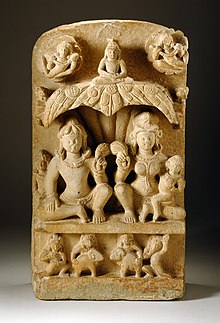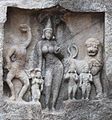Ambika (Jainism)
| Ambika | |
|---|---|
 An image of Ambika in Cave 34 of the Ellora Caves | |
| Genealogy | |
| Spouse | Sarvanha (Dig.) Gomedha (Śvēt.) |
| Part of a series on |
| Jainism |
|---|
 |
In Jainism, Ambika (Sanskrit: अम्बिका, Odia: ଅମ୍ବିକା Ambikā "Mother") or Ambika Devi (अम्बिका देवी Ambikā Devī "the Goddess-Mother") is the yakshini "dedicated attendant deity" or Śāsana Devī "protector goddess" of the 22nd Tirthankara, Neminatha. She is also known as Ambai, Amba, Kushmandini and Amra Kushmandini.[1] She is often shown with one or more children and often under a tree. She is frequently represented as a pair (Yaksha Sarvanubhuti on the right and Kushmandini on the left) with a small Tirthankar image on the top.[2] The name ambika literally means mother, hence she is Mother Goddess. The name is also a common epithet of Hindu Goddess Parvati.[3]
Etymology
[edit]The name Ambika is a Sanskrit word, that translates to mother.[4][5]
Legend
[edit]
According to Jain texts, Ambika is said to have been an ordinary woman named Agnila who became a Goddess.[6] She lived in the city of Girinagar with her husband, Soma and her two children, Siddha and Buddha as per the Śvetāmbara tradition, or with her husband Somasarman and her two children, Shubhanakar and Prabhankara as per the Digambara tradition.[7]
One day, Soma invited Brahmins to perform Śrāddha (funeral ceremony) and left Agnila at home. Varadatta, the chief disciple of Neminatha,[8] was passing by and asked for food from Agnila to end his month-long fast.[9] Soma and Brahmins were furious at her as they considered the food to be impure now. Soma drove her out of the house along with her children; she went up a hill.[7]
She was blessed with power for her virtue, the tree she sat down under became a Kalpavriksha, wish-granting tree, and dry water tank started overflowing with water. Demi-gods were angry at the treatment meted out to Angila and decided to drown the entire village, but her house. After seeing this Soma and the Brahmins felt this was because of her saintliness and begged her for forgiveness. Upon seeing her husband approach her, afraid of punishment, a scared Angila committed suicide by jumping off the cliff, but she was instantly reborn as Goddess Ambika.[10] Her husband was reborn as a lion and he came to her, licked her feet and became her vehicle.[7] Neminatha initiated her two sons and Ambika became Neminatha's yakshi.[11][12][5]
Legacy
[edit]Ambika is the yakshi of Neminatha with Sarvanha (according to Digambara tradition) or Gomedha (according to Śvētāmbara tradition) as yaksha.[8]
Worship
[edit]
A number of images and temples of Ambika are found in India.[11] Goddess Ambika along with Padmavati and Chakreshvari is held as an esteemed deity and along with Tirthankaras, is worshipped by Jains.[13][14] Ambika and Padmavati are associated with tantric rituals. These tantric rites involves yantra-vidhi, pitha-sthapana and mantra-puja.[15][16] Ambika is also called Kalpalata and kamana devi a goddess that fulfils. At Vimal Vasahi, Ambika is carved kalpalata, a wish fulfilling creeper.[17] Ambika is also associated with childbirth and prosperity.[10][18] Ambika is also worshiped as Kuladevi or gotra-devi.[19] Ambika is the kula-devi of the Porwad(Pragvat) Jain community. While she is worshipped by all Śvetāmbara Murtipujaka Jains, she is specially revered by the Porwads.[20]
According to a Digambara legend, after completing construction of Gommateshwara statue, Chavundaraya organised a mahamastakabhisheka with five liquids, milk, tender coconut, sugar, nectar and water collected in hundreds of pots but liquid could not flow below the navel of the statue. Kushmandini appeared disguised as a poor old woman holding milk in the shell of half of a white Gullikayi fruit and the abhisheka was done from head to toe. Chavundaraya realised his mistake and did abhishek without pride and arrogance and this time abhisheka was done from head to toe.[21] Worship of Kushmandini devi or Ambika is an integral part of Jain rituals in Shravanabelagola.[22]
In literature
[edit]- Ambika-Kalpa, Ambika-Tadamka, Ambikatatanka, Ambika-stuti, Ambika-devi-stuti and Bhairava-Padmavati-Kalpa are tantric text to worship Ambika.[15]
- Ambika-stavana, is hymn to Ambika, compiled by Vastupala, minister of Chalukyas, in the 13th century.[23]
- Ambika-devi-kalpa of Acharya Jinprabha suri, 14th century.[23]
- Aparajita-prccha is hymn to Ambika, compiled by Bhuvanadeva, 12th-13th century.[23]
Iconography
[edit]
According to the tradition, her colour is golden and her vehicle is a lion. She has four arms. In her two right hands, she carries a mango and in the other a branch of a mango tree. In one of her left hands, she carries a rein and in the other she has her two sons, Priyankara and Shubhankara.[24][25][26][27] In South India Ambika is shown to have dark blue complexion.[23] Ambika is depicted as sashandevi for other tirthankars as well. Ambika is often represent with Bahubali.[28] Yaksha-Yakshi pair sculptures of Ambika and Sarvahanabhuti are one of the most favoured along with Gomukha-Chakreshwari and Dharanendra-Padmavati.[18]
Ambika has been popular an independent deity as well.[10][29] It is speculated that the origin of Ambika is attributed to elements of three different deities - first, goddess riding on the lion from Durga; Second, some goddess associated with mangoes and mango trees; Third, Kushmanda.[30]
The Amba-Ambika group of caves of Manmodi Caves, dated 2nd century CE, has carving of Goddess Ambika.[31] The oldest sculpture of Ambika is an idol from Akota Bronzes dated 550—600 CE.[32] A sculpture of Ambika was discovered at Karajagi village in Haveri taluk. The sculpture has a two-line Sanskrit inscription in Nagari script about the date of its installation - "Ambikadevi, Shaka 1173, Virodhikrit. Samvatsara, Vaishakha Shuddha 5, Guruvara". This corresponds to Thursday, 27 April 1251 AD.[33]
-
Ambika sculpture from Kushan Empire
-
Image depicting Goddess Ambika in LACMA, 6th-7th century
-
Carving of Ambikadevi Kalugumalai Jain Beds, 8th century
-
Image depicting Goddess Ambika from Karnataka, India, c. 900 CE, Norton Simon Museum
-
Sculpture of Goddess Ambika, 1034 AD, British Museum
-
Goddess Ambika in Museum Rietberg, 11th century
-
Sculpture of Gomedh and Ambika at Maharaja Chhatrasal Museum, 11th century
-
Sarvanubhuti and Kushmandini with Jinas, 11 century, Art Gallery of New South Wales
-
Goddess Ambika idol, Victoria and Albert Museum, 1150-1200 AD
-
Goddess Ambika - Medieval Period (Government Museum, Mathura)
Main temples
[edit]
The Amba-Ambika group of caves of Manmodi Caves, dated 2nd century CE, is dedicated to Goddess Ambika.[31] The Ambika Temple, Girnar dates back 784 CE and is considered one of the oldest temple dedicated to Goddess Ambika. The worship of Goddess Ambika, the tutelary deity of Shri Munisuvrata-Nemi-Parshva Jinalaya, Santhu is popular among devotees.[34]
The major temples of Shri Ambika Devi include:
- Ambikadevi temple at Kodinar, Saurashtra in the state of Gujarat is an important pilgrimage center built in pre-medieval period.[34]
- Shri Kuladevi Ambikadevi Jain Temple, Takhatgarh in Pali district of Rajasthan state.
- Shri Kuladevi Ambikadevi Jain Temple, Padarli, Rajasthan.
- Shri Ambika Temple, Girnar
See also
[edit]References
[edit]Citation
[edit]- ^ "JAINpedia > Themes > Practices > Ambikā or Kuṣmāṇḍinī". www.jainpedia.org. Retrieved 4 May 2020.
- ^ Stele with 'yaksha-yakshini' couple and Jinas, Pratapaditya Pal, ‘Goddess: divine energy’, pg.30., Art Gallery of New South Wales, 2006
- ^ Pal 1986, p. 45.
- ^ Chugh 2016, p. 178.
- ^ a b Wiley 2009, p. 33.
- ^ Chandraprabha Jain Temple & Chennai museum, p. 48.
- ^ a b c Shah 1987, p. 257.
- ^ a b Shah 1987, p. 165.
- ^ Tiwari 1989, p. 33.
- ^ a b c Dundas 2002, p. 214.
- ^ a b Kumar 2001, p. 112.
- ^ Pereira 2001, pp. 62–63.
- ^ Krishna 2014, p. 68.
- ^ Chawdhri 1992, p. 128.
- ^ a b Tiwari 1989, p. 29.
- ^ Shah 1987, p. 221.
- ^ Kumar 2001, p. 107.
- ^ a b Tiwari 1989, p. 13.
- ^ Shah 1987, p. 65.
- ^ The Muslim Review - Volumes 1-2, p. 29
- ^ Deccan Chronicle & 2018 Mahamastakabhisheka.
- ^ Gier 2001, p. 83.
- ^ a b c d Tiwari 1989, p. 28.
- ^ Jain 2009, p. 63.
- ^ Tiwari 1989, p. 132.
- ^ Dalal 2010, p. 158.
- ^ "Ambika". 21 June 2018.
- ^ Shah 1995, p. 17.
- ^ Singh 2008, p. 55.
- ^ Mishra & Ray 2016, p. 168.
- ^ a b Fergusson & Burgess 1880, p. 258.
- ^ Shah 1987, p. 249.
- ^ Rare sculpture of Jain Yakshi found in Haveri Taluk, The New Indian Express, 18 October 2013, archived from the original on 22 December 2015
- ^ a b Tiwari 1989, p. 145.
Sources
[edit]Books
[edit]- Chugh, Lalit (2016). Karnataka's Rich Heritage - Art and Architecture (From Prehistoric Times to the Hoysala Period ed.). Notion Press. ISBN 9789352068258.
- Dalal, Roshen (2010), The Religions of India: A Concise Guide to Nine Major Faiths, Penguin Books India, ISBN 9780143415176
- Fergusson, James; Burgess, James (1880). The cave temples of India. London : Allen. pp. 258ff.
- Pal, Pratapaditya (1986), Indian Sculpture: Circa 500 B.C.-A.D. 700, University of California Press, ISBN 9780520064775
- Chawdhri, L. R. (1992), Secrets of Yantra, Mantra and Tantra, Sterling Publishers Pvt. Ltd, ISBN 9781845570224
- Shah, Umakant Premanand (1995), Studies in Jaina Art and Iconography and Allied Subjects in Honour of Dr. U.P. Shah, Abhinav Publications, ISBN 9788170173168
- Mishra, Susan Verma; Ray, Himanshu Prabha (2016), The Archaeology of Sacred Spaces: The temple in western India, 2nd century BCE–8th century CE, Routledge, ISBN 9781317194132
- Pereira, José (2001), Monolithic Jinas, Motilal Banarsidass, ISBN 9788120823976
- Shah, Umakant Premanand (1987), Jaina-rūpa-maṇḍana: Jaina iconography, Abhinav Publications, ISBN 81-7017-208-X
- Tiwari, Dr. Maruti Nandan Prasad (1989), Ambika in Jaina Art and Literature, Bharatiya Jnanpith
- Jain, Arun Kumar (2009), Faith & Philosophy of Jainism, Gyan Publishing House, ISBN 9788178357232, retrieved 8 October 2017
- Wiley, Kristi L. (2009), The A to Z of Jainism, vol. 38, The Scarecrow Press, ISBN 978-0-8108-6337-8
- Gier, Nicholas F. (2001), Spiritual Titanism: Indian, Chinese, and Western Perspectives, SUNY Press, ISBN 9780791492826
- Dundas, Paul (2002), The Jains, Psychology Press, ISBN 9780415266055
- Krishna, Nanditha (2014), Sacred Plants of India, Penguin UK, ISBN 9789351186915
- Singh, Ram Bhushan Prasad (2008), Jainism in Early Medieval Karnataka, Motilal Banarsidass, ISBN 9788120833234
- Kumar, Sehdev (2001), A Thousand Petalled Lotus: Jain Temples of Rajasthan : Architecture & Iconography, Abhinav Publications, ISBN 9788170173489
Web
[edit]- "MANUAL ON CONSERVATION AND RESTORATION OF MONUMENTS". Department of museums, Government of Tamil Nadu. Archived from the original on 15 August 2019. Retrieved 15 August 2019.
- "2018 Mahamastakabhisheka: Bahubali – 1,000 year legend towers on". Deccan Chronicle. 16 February 2018.










